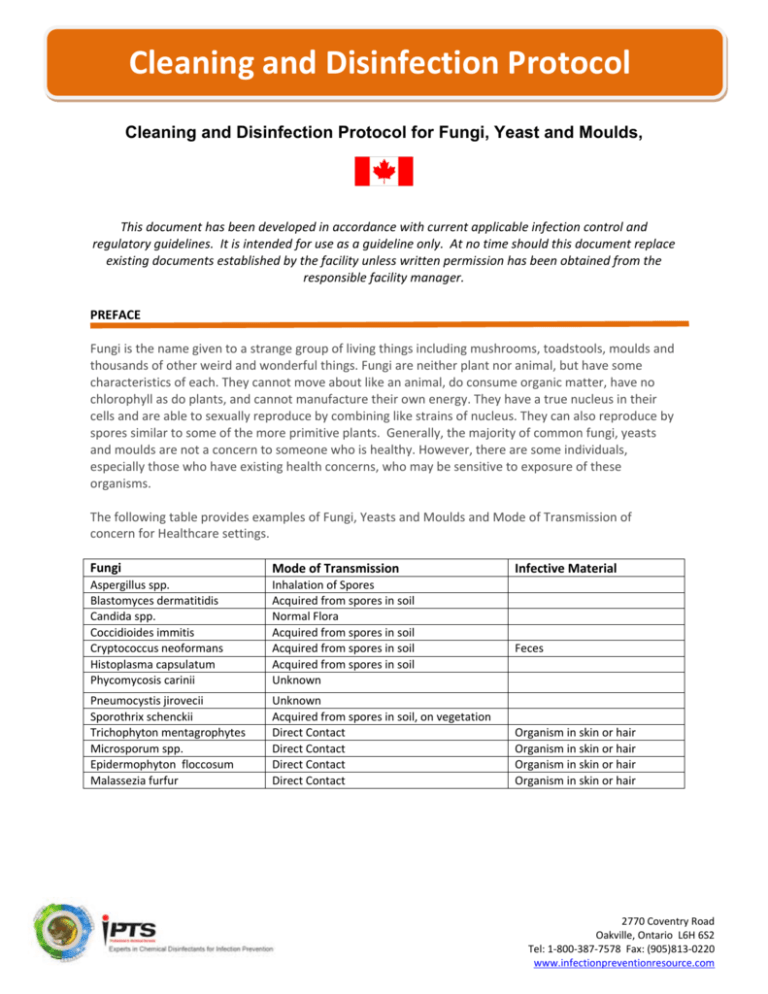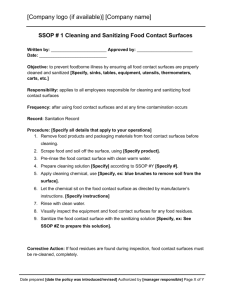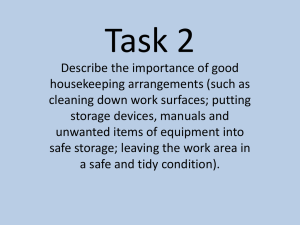Cleaning and Disinfection Protocol
advertisement

Cleaning and Disinfection Protocol Cleaning and Disinfection Protocol for Fungi, Yeast and Moulds, This document has been developed in accordance with current applicable infection control and regulatory guidelines. It is intended for use as a guideline only. At no time should this document replace existing documents established by the facility unless written permission has been obtained from the responsible facility manager. PREFACE Fungi is the name given to a strange group of living things including mushrooms, toadstools, moulds and thousands of other weird and wonderful things. Fungi are neither plant nor animal, but have some characteristics of each. They cannot move about like an animal, do consume organic matter, have no chlorophyll as do plants, and cannot manufacture their own energy. They have a true nucleus in their cells and are able to sexually reproduce by combining like strains of nucleus. They can also reproduce by spores similar to some of the more primitive plants. Generally, the majority of common fungi, yeasts and moulds are not a concern to someone who is healthy. However, there are some individuals, especially those who have existing health concerns, who may be sensitive to exposure of these organisms. The following table provides examples of Fungi, Yeasts and Moulds and Mode of Transmission of concern for Healthcare settings. Fungi Mode of Transmission Infective Material Aspergillus spp. Blastomyces dermatitidis Candida spp. Coccidioides immitis Cryptococcus neoformans Histoplasma capsulatum Phycomycosis carinii Inhalation of Spores Acquired from spores in soil Normal Flora Acquired from spores in soil Acquired from spores in soil Acquired from spores in soil Unknown Pneumocystis jirovecii Sporothrix schenckii Trichophyton mentagrophytes Microsporum spp. Epidermophyton floccosum Malassezia furfur Unknown Acquired from spores in soil, on vegetation Direct Contact Direct Contact Direct Contact Direct Contact Feces Organism in skin or hair Organism in skin or hair Organism in skin or hair Organism in skin or hair 2770 Coventry Road Oakville, Ontario L6H 6S2 Tel: 1‐800‐387‐7578 Fax: (905)813‐0220 www.infectionpreventionresource.com Cleaning and Disinfection Protocol Cleaning and Disinfection Protocol for Fungi, Yeast and Moulds, PREPARATION Transmission of fungi, yeast and moulds is generally acquired from spores found in soil or vegetation and either ingested or inhaled. Person‐to‐Person transmission is not of general concern with fungi with the exception of organisms that cause athlete’s foot or ringworm where the fungi are found on the skin and can be transmitted via direct contact. Appropriate personal protection should be taken for those responsible for the decontamination of a room or area especially after construction where fungal spores may be present. Appropriate bio‐security practices should be applied, including limiting the amount of aerosols generated and disturbance to dust / soil in the area to be cleaned and disinfected. PROTECTIVE BARRIERS Appropriate personal protection should be taken for those responsible for the decontamination of a room or area. 1. Disposable gloves. Gloves should be changed as required, i.e., when torn, when hands become wet inside the glove or when moving between patient rooms. 2. Household gloves can be worn, but they must be discarded when the cleaning is complete. 3. Protective Eye wear (goggles, face shield or mask with eye protection) 4. Masks (surgical or procedural masks sufficient) 5. Gowns PRODUCTS All disinfectant or disinfect‐cleaner products to be use for cleaning and disinfection of Patient Care Equipment or Devices and environmental surfaces must be approved by Health Canada and carry a Drug Identification Number (DIN). Products claiming to be a disinfectant but do not carry a DIN have not been approved for sale in Canada and should not be used. Choose products that either have proven efficacy against the specific fungi of interest or that have been proven efficacious against Trichophyton mentagrophytes, the designated surrogate by Health Canada for Fungicidal activity. Disinfectant Chemistries Approved for Low Level Disinfection include: 1. Alcohol 2. Accelerated Hydrogen Peroxide 3. Sodium Hypochlorite 4. Quaternary Ammonium Compounds 5. Phenolics The concentration and contact time for each product will differ. For that reason it is important to read the product label prior to commencing any cleaning and disinfection process. 2770 Coventry Road Oakville, Ontario L6H 6S2 Tel: 1‐800‐387‐7578 Fax: (905)813‐0220 www.infectionpreventionresource.com Cleaning and Disinfection Protocol Cleaning and Disinfection Protocol for Fungi, Yeast and Moulds, RECOMMENDED PROCEDURES FOR CLEANING AND DISINFECTION Summary of Procedure: Apply the solution to either the surface or device surface or to cloth. Clean all horizontal surfaces in the room ensuring that the cloth is changed when soiled. Place used cloth in a marked plastic‐lined waste receptacle. Disinfect all horizontal surface of the room by applying the disinfectant and allowing for contact time as per the product label. If using cloth & bucket method with double dipping, once room has been cleaned discard all unused cleaning solution before proceeding to the next room. Allow surfaces to air dry or wipe dry if surfaces are still wet after the contact time as been achieved. Periodic rinsing of soft surfaces such as vinyl or naugahyde is suggested as well as equipment regularly handled by hand. 1. Gather all equipment, cleaning solutions and materials required to clean the patient care devices. 2. WASH hands and put gloves prior to cleaning the devices. Personal protective equipment should be changed if torn or soiled. 3. Visible or gross soil present and/or blood or body fluid spills must be removed prior to cleaning. [See Protocol for Cleaning & Disinfecting a Blood or Body Fluid spill.] 4. As appropriate clean all surfaces in the patient room, including the patient care equipment or devices using a detergent or enzymatic solution. Where appropriate, dismantle the devices to ensure that all surfaces can be cleaned and move all objects to ensure all environmental surfaces have been cleaned. To ensure that cross contamination does not occur use clean cloths for each device to be cleaned. If using an open bucket system, ensure that solutions do not become contaminated (NO DOUBLE DIPPING). 5. As many fungi are transmitted via inhalation of the spores, avoid spraying surfaces or cleaning in such a manner as to generate aerosols. 6. To disinfect all surfaces of the patient care devices and environmental surfaces, apply the disinfectant and allow surfaces to remain wet for the appropriate contact time as specified on the product label. 7. If using a 1‐Step Cleaning‐Disinfecting Solution a separate cleaning step is not necessary unless the surfaces are visibly soiled. To ensure disinfection occurs, the cleaner‐disinfectant solution may need to be applied multiple times in order to achieve the contact time as specified on the product label. 2770 Coventry Road Oakville, Ontario L6H 6S2 Tel: 1‐800‐387‐7578 Fax: (905)813‐0220 www.infectionpreventionresource.com Cleaning and Disinfection Protocol Cleaning and Disinfection Protocol for Fungi, Yeast and Moulds, 8. Soiled rags should be placed in a bag for laundering. Disposable cloths should be disposed as regular waste in garbage bags. 9. Remove and discard gloves, WASH hands. RECOMMENDED PROCEDURES FOR CLEANING AND DISINFECTION OF BLOOD & BODY FLUID SPILLS Appropriate personal protective equipment should be worn for cleaning up a body fluid spill. Gloves should be worn during the cleaning and disinfecting procedures. If the possibility of splashing exists, the worker should wear a face shield and gown. For large spills, overalls, gowns or aprons as well as boots or protective shoe covers should be worn. Personal protective equipment should be changed if torn or soiled, and always removed before leaving the location of the spill, and then wash hands. 1. WASH hands and put on gloves. 2. If the possibility of splashing exists, the worker should wear a face shield and gown. For large spills, overalls, gowns or aprons as well as boots or protective shoe covers should be worn. Personal protective equipment should be changed if torn or soiled and always removed before leaving the location of the spill. 3. Apply the Disinfectant Solution to spill. 4. Blot up the blood with disposable towels. Dispose of paper towel in plastic‐lined waste receptacle. 5. Spray or wipe surface with the Disinfectant Solution to the area and ensure the appropriate contact time is met as specified on the product label. Wipe dry with disposable paper towel. Discard paper towel as above. 6. Remove gloves and dispose in plastic‐lined waste receptacle. 7. WASH hands. DISPOSAL OF INFECTION MATERIAL All cleaning cloths gloves and handled tools used for the decontamination of a suspected Avian Flu virus case must be placed in a clearly marked plastic lined waste receptacle. Decontaminate all wastes before disposal; steam sterilization, chemical disinfection and or incineration. 2770 Coventry Road Oakville, Ontario L6H 6S2 Tel: 1‐800‐387‐7578 Fax: (905)813‐0220 www.infectionpreventionresource.com Cleaning and Disinfection Protocol Cleaning and Disinfection Protocol for Fungi, Yeast and Moulds, REFERENCES APIC, Ready Reference To Microbes, 2002 Best Practices for Cleaning, Disinfection and Sterilization in All Health Care Settings, Provincial Infectious Diseases Advisory Committee (PIDAC), February 2010 Best Practices for Environmental Cleaning for Prevention and Control of Infections in All Health Care Settings, PIDAC, December 2009 Guidelines for Environmental Infection Control in Healthcare Facilities, CDC. MMWR June 2003, Vol 52, No RR‐10 Guideline for Isolation Precautions: Preventing Transmission of Infectious Agents in Healthcare Settings, HICPAC, 2007 Rutala WA & Weber DJ. The benefits of surface disinfection. AJIC 2004;32(4) 226‐229 Mayhall CG. Hospital Epidemiology and Infection Control, 3rd Ed. Philadelphia. Lippincott Williams & Wilkins, 2004 2770 Coventry Road Oakville, Ontario L6H 6S2 Tel: 1‐800‐387‐7578 Fax: (905)813‐0220 www.infectionpreventionresource.com









